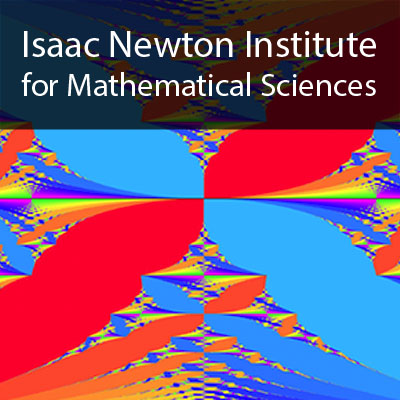Periodic spectral problem for the massless Dirac operator
56 mins 52 secs,
266.05 MB,
WebM
640x360,
29.97 fps,
44100 Hz,
638.75 kbits/sec
Share this media item:
Embed this media item:
Embed this media item:
About this item

| Description: |
Vassiliev, D (University College London)
Wednesday 25 March 2015, 15:00-16:00 |
|---|
| Created: | 2015-03-31 11:39 |
|---|---|
| Collection: | Periodic and Ergodic Spectral Problems |
| Publisher: | Isaac Newton Institute |
| Copyright: | Vassiliev, D |
| Language: | eng (English) |
| Distribution: |
World
|
| Explicit content: | No |
| Aspect Ratio: | 16:9 |
| Screencast: | No |
| Bumper: | UCS Default |
| Trailer: | UCS Default |
| Abstract: | Co-author: Michael Levitin (University of Reading)
Periodic spectral problems are normally formulated in terms of the Schrodinger operator. The aim of the talk is to examine issues that arise if one formulates a periodic spectral problem in terms of the Dirac operator. The motivation for the particular model considered in the talk does not come from solid state physics. Instead, we imagine a single massless neutrino living in a compact 3-dimensional universe without boundary. There is no electromagnetic field in our model because a neutrino does not carry an electric charge and cannot interact (directly) with an electromagnetic field. The role of the electromagnetic covector potential is therefore taken over by the metric. In other words, we are interested in understanding how the curvature of space affects the energy levels of the neutrino. More specifically, we consider the massless Dirac operator on a 3-torus equipped with Euclidean metric and standard spin structure. It is known that the eigenvalues can be calculated explicitly: the spectrum is symmetric about zero and zero itself is a double eigenvalue. Our aim is to develop a perturbation theory for the eigenvalue with smallest modulus with respect to perturbations of the metric. Here the application of perturbation techniques is hindered by the fact that eigenvalues of the massless Dirac operator have even multiplicity, which is a consequence of this operator commuting with the antilinear operator of charge conjugation (a peculiar feature of dimension 3). We derive an asymptotic formula for the eigenvalue with smallest modulus for arbitrary perturbations of the metric and present two particular families of Riemannian metrics for which the eigenvalue with smallest modulus can be evaluated explicitly. We also establish a relation between our asymptotic formu la and the eta invariant. [1] R.J.Downes, M.Levitin and D.Vassiliev, Spectral asymmetry of the massless Dirac operator on a 3-torus, Journal of Mathematical Physics, 2013, vol. 54, article 111503. |
|---|---|
Available Formats
| Format | Quality | Bitrate | Size | |||
|---|---|---|---|---|---|---|
| MPEG-4 Video | 640x360 | 1.94 Mbits/sec | 828.19 MB | View | Download | |
| WebM * | 640x360 | 638.75 kbits/sec | 266.05 MB | View | Download | |
| iPod Video | 480x270 | 522.1 kbits/sec | 217.39 MB | View | Download | |
| MP3 | 44100 Hz | 249.73 kbits/sec | 104.11 MB | Listen | Download | |
| Auto | (Allows browser to choose a format it supports) | |||||

